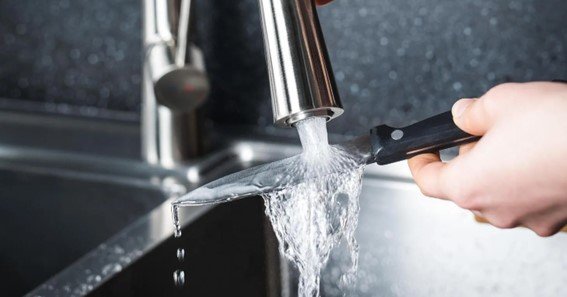Maintaining proper hygiene in the kitchen is essential for food safety, and understanding when a knife must be cleaned and sanitized is a fundamental aspect of this practice. Regular cleaning and sanitization of knives prevent cross-contamination and the spread of harmful bacteria, ensuring a safe cooking environment.
Key Instances for Cleaning and Sanitizing Knives
- After Each Use: It’s imperative to clean and sanitize your knife after every use to remove food particles and bacteria.
- When Switching Between Different Food Types: Transitioning from cutting raw meat to vegetables without cleaning the knife can lead to cross-contamination. Always clean and sanitize knives between handling different food items.
- After Handling Raw Meat, Poultry, or Seafood: These foods often harbor harmful bacteria like Salmonella and E. coli. Cleaning and sanitizing knives immediately after use with these items is crucial.
- After Contact with Allergenic Foods: If preparing food for individuals with allergies, sanitize knives thoroughly to prevent allergen transfer.
- Before Storage: Cleaning and sanitizing knives before storing them prevents bacterial growth and maintains their condition.
Proper Cleaning and Sanitizing Techniques
- Cleaning: Wash knives with hot, soapy water, paying attention to the blade and handle. Rinse thoroughly to remove soap residue.
- Sanitizing: After cleaning, sanitize knives using a solution of one tablespoon of unscented household bleach per gallon of water. Immerse the knife for at least one minute, then rinse and dry.
- Drying: Dry knives immediately after sanitizing to prevent rust and bacterial growth.
FAQ
1. Why is it important to clean and sanitize knives after each use?
Cleaning and sanitizing knives after each use remove food residues and bacteria, preventing cross-contamination and foodborne illnesses.
2. Can I use a dishwasher to clean and sanitize knives?
While some knives are dishwasher-safe, handwashing is recommended to maintain sharpness and prevent damage.
3. What is the difference between cleaning and sanitizing?
Cleaning removes visible dirt and food particles, while sanitizing reduces the number of harmful bacteria to safe levels.
4. How often should knives be sanitized in a commercial kitchen?
In commercial settings, knives should be cleaned and sanitized after each use and at least every four hours during continuous use.
5. What are the risks of not properly cleaning and sanitizing knives?
Failure to clean and sanitize knives can lead to cross-contamination, foodborne illnesses, and the spread of harmful bacteria.
Understanding when a knife must be cleaned and sanitized is vital for maintaining a safe and hygienic kitchen environment. By adhering to proper cleaning and sanitizing practices, you can prevent cross-contamination and ensure the safety of the food you prepare.










